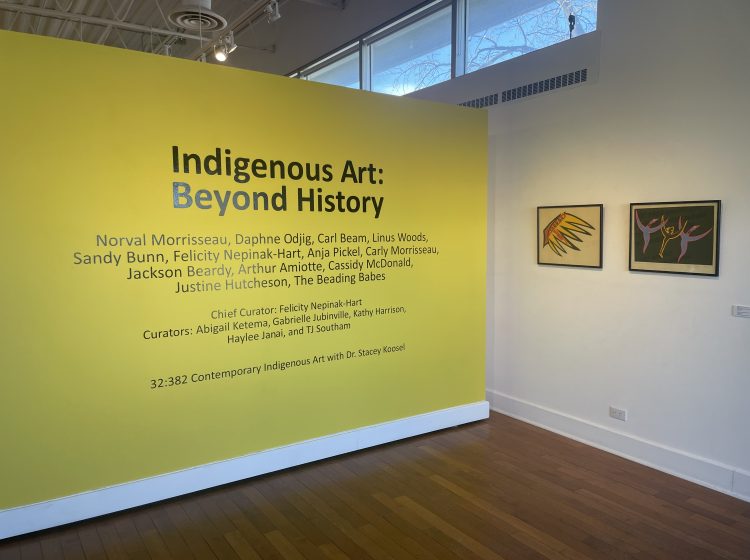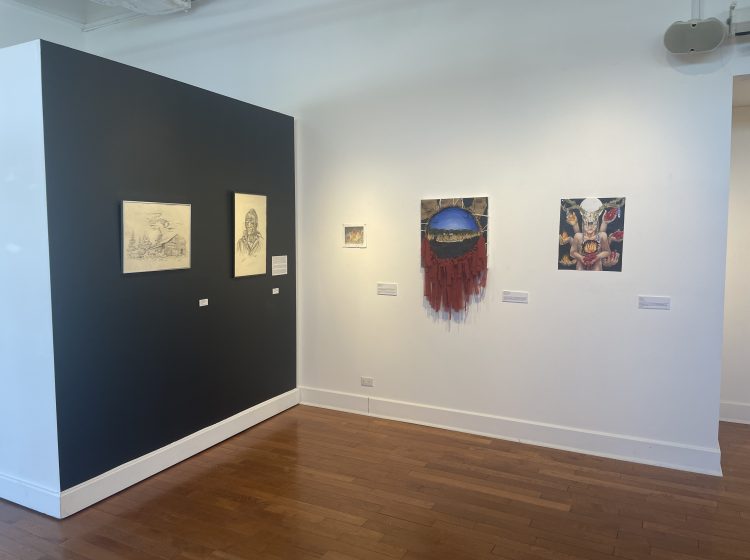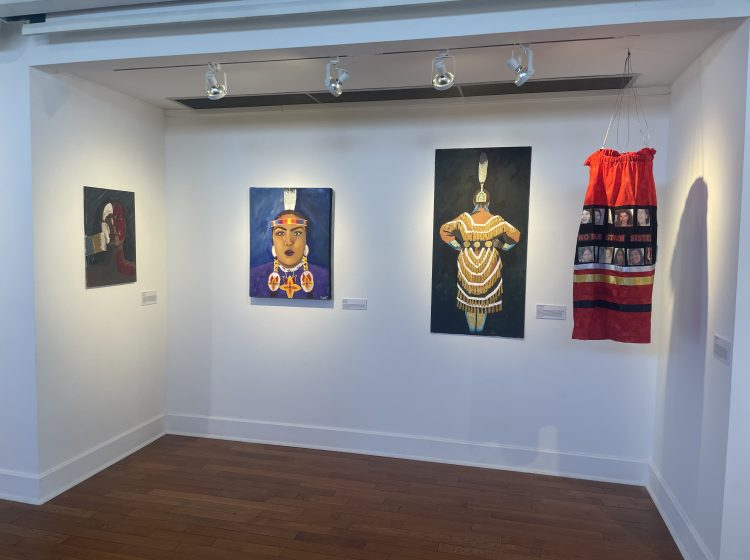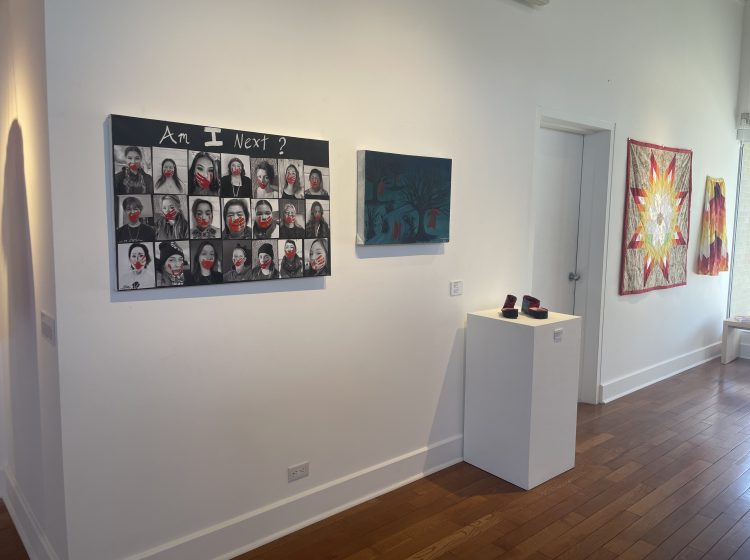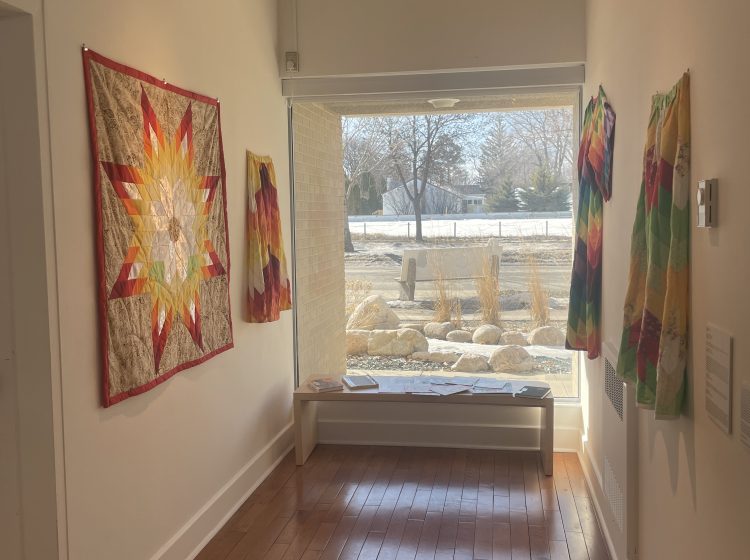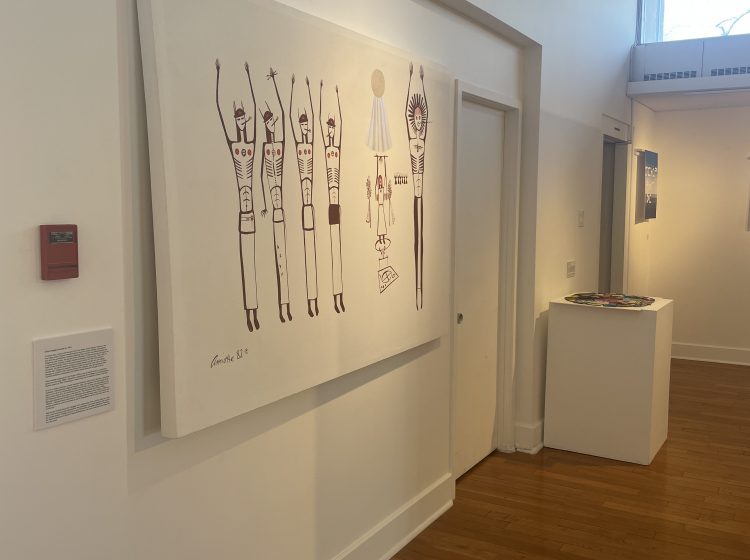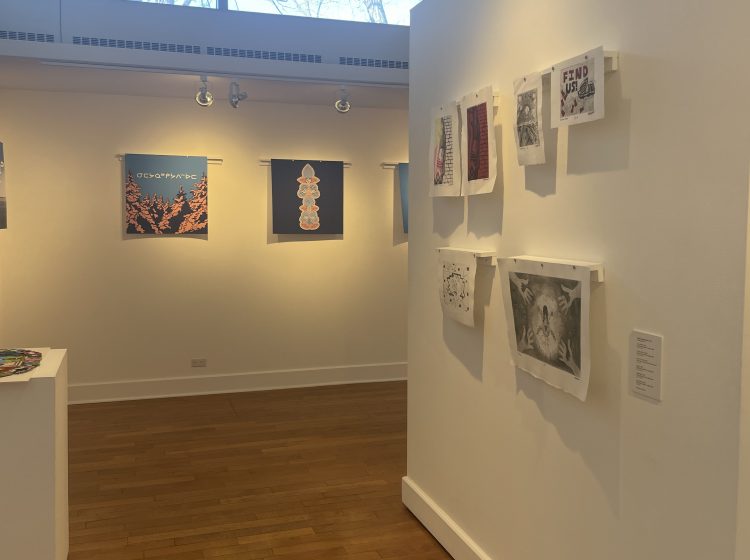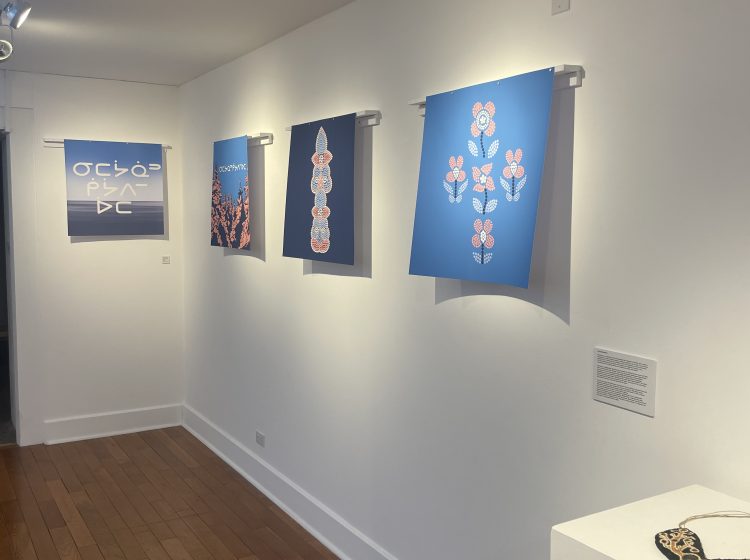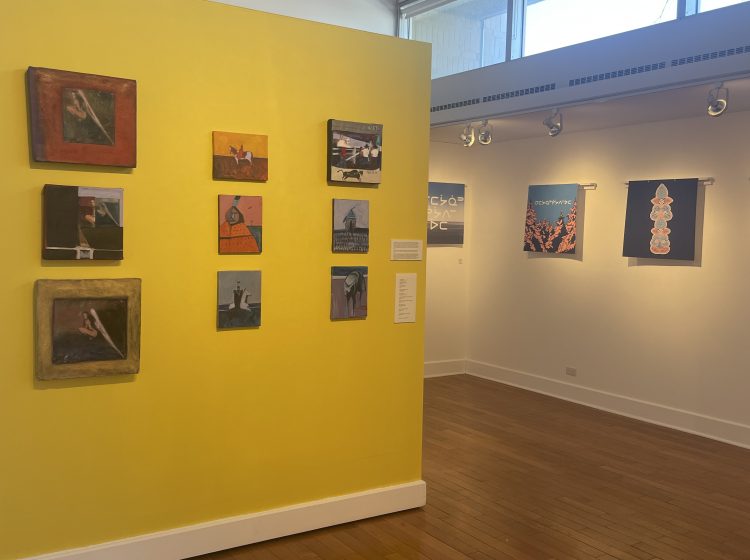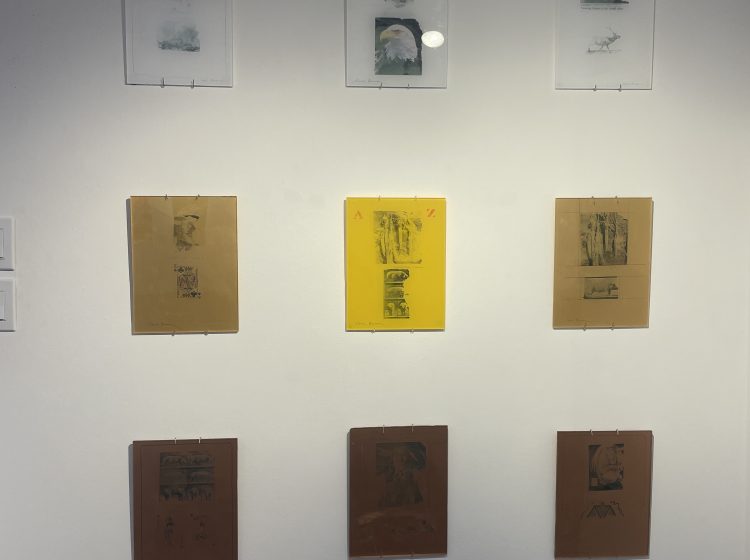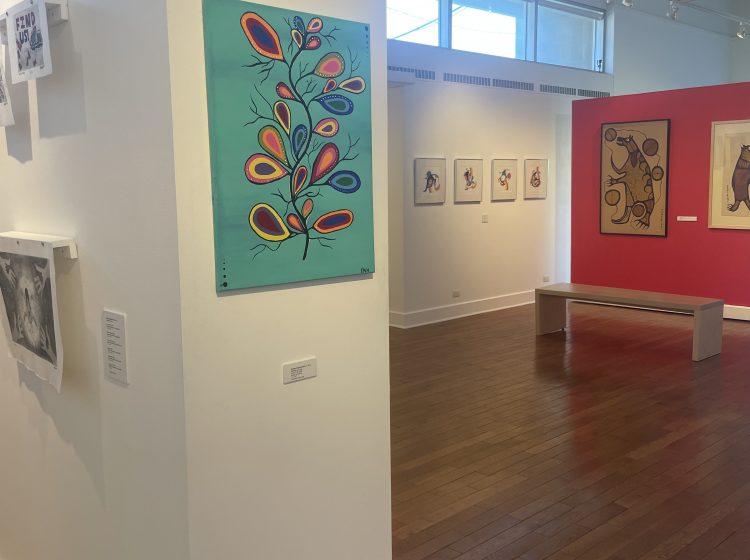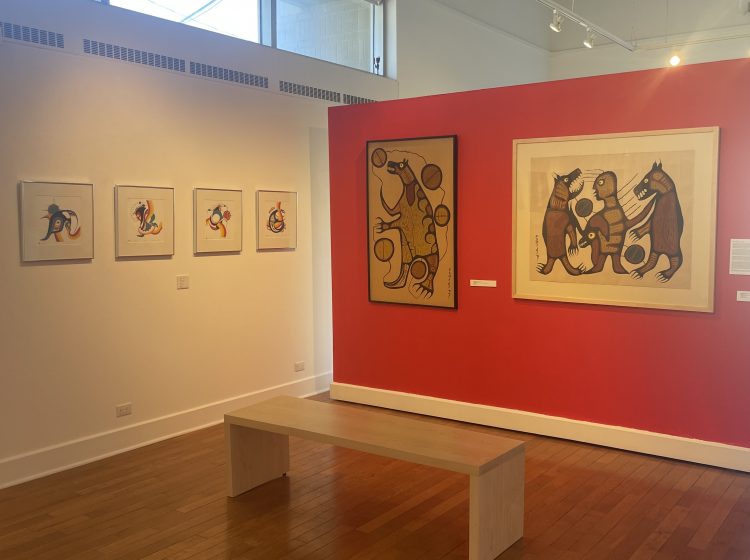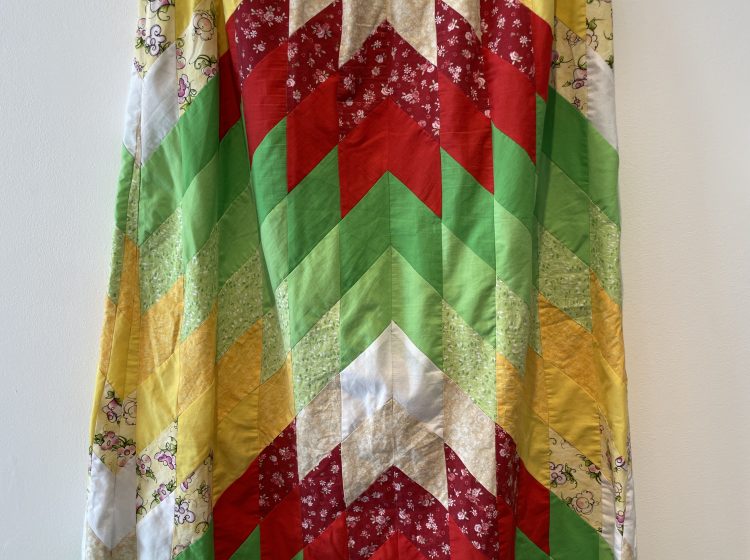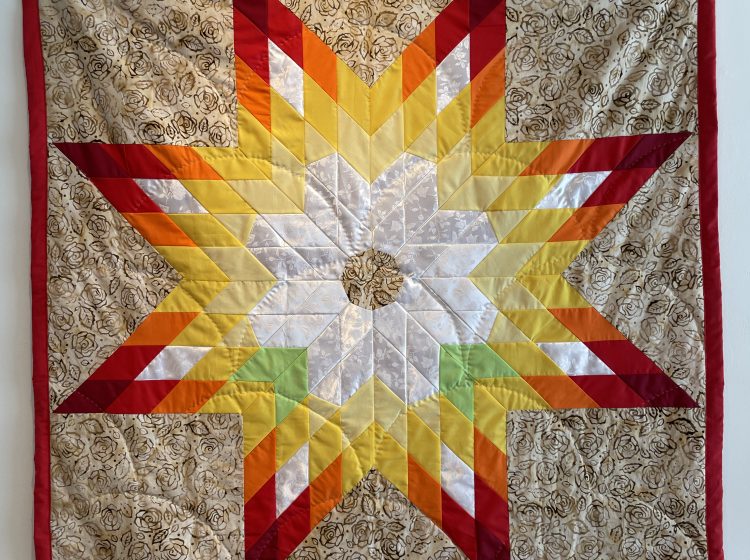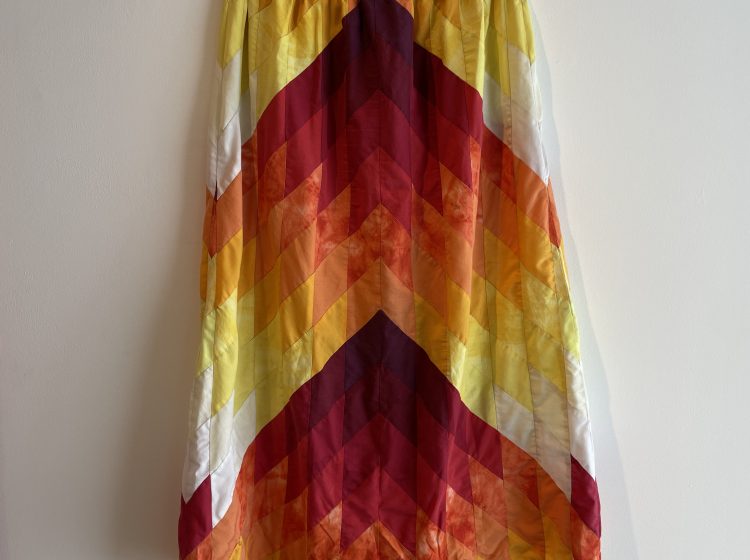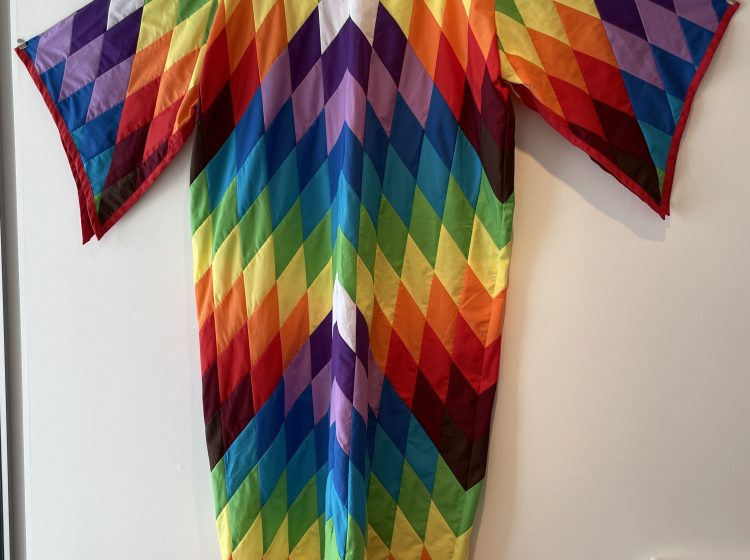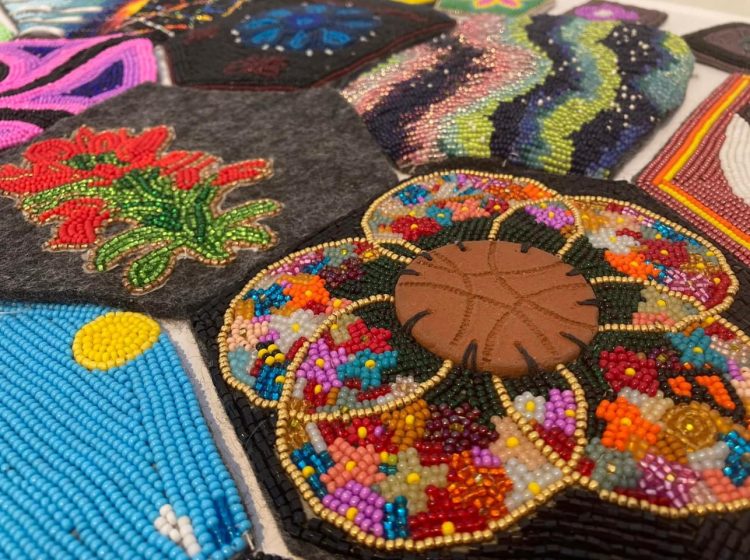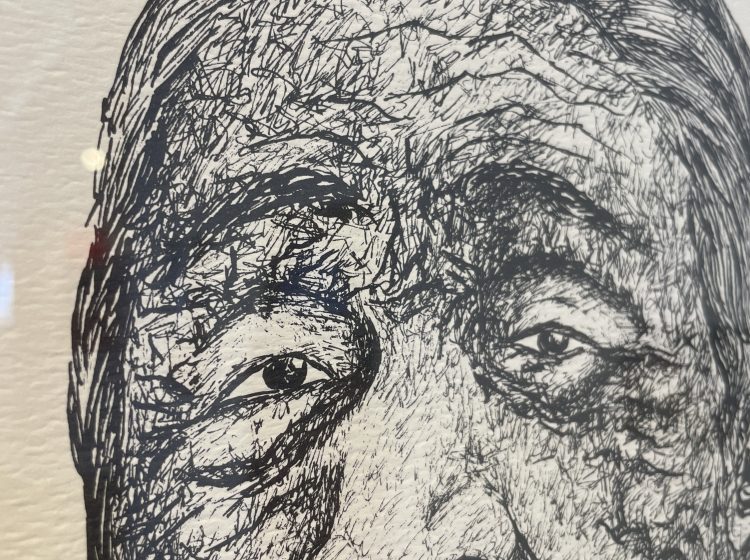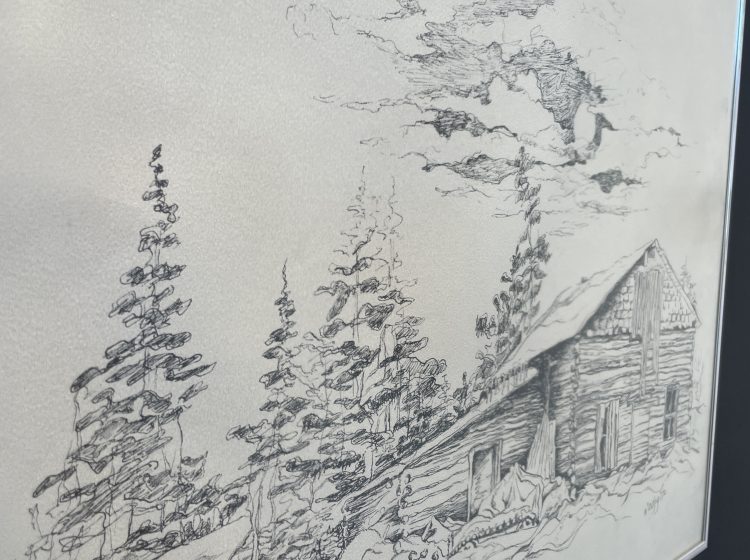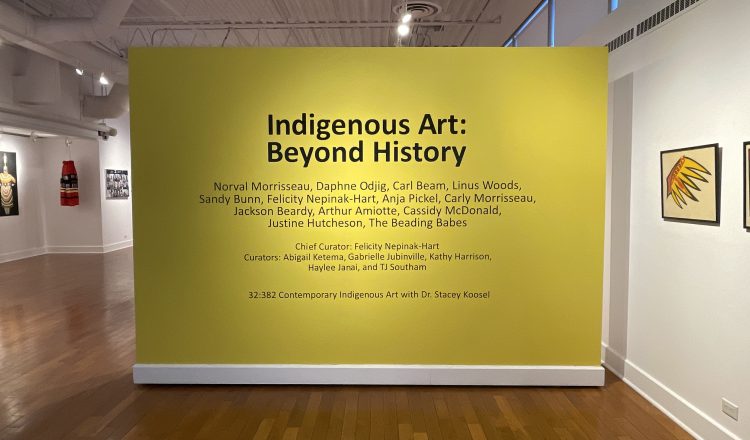32:382 Contemporary Indigenous Art
Class Curation Project with Dr. Stacey Koosel
Early career works by Anishinaabe artists Daphne Odjig and Norval Morrisseau, known as the Grandmother and Grandfather of contemporary Indigenous art, guide us into Indigenous Art: Beyond History, an exhibition that spans almost sixty years of contemporary Indigenous art, with works by established artists, emerging artists, students, alumni, former BU faculty, and community members.
The exhibition was organized by art historian and curator, Dr. Stacey Koosel (Métis). Her Contemporary Indigenous Art course provided the students with a hands-on opportunity to not only research Indigenous contemporary art, but to work with artists and other experts to create a well-researched exhibition that contributes to knowledge in the field of contemporary Indigenous art. As the course was based on Indigenous curatorial praxis, it is an Indigenous led project with project leadership by Chief Curator Felicity Nepinak-Hart (Ojibway-Cree), who sought out student Indigenous contemporary artists and Alumni of Brandon University. It was important to Felicity to showcase student artworks because self representation is so important to young Indigenous people. The established Indigenous contemporary artists in this exhibition are acknowledged as having paved the way for young Indigenous artists to have a free space to create such artwork that engages healing, growth, and self discovery.
Any art historian or curator in the field of contemporary Indigenous art would be floored by the vast collection of important artworks that are formally or informally part of Brandon University’s Art Collection. Research into the collection for this exhibition was greatly supported by Emeritus Professor Colleen Cutschall (Oglala-Sicangu Lakota) who founded the Visual and Aboriginal Arts Department at Brandon University. Thanks to her we were able to learn the provenance of many valuable works in the collection, including how Sam Corrigan and Art Blue, who founded one of the first Native Studies Departments in Canada at Brandon University in 1970, acquired an impressive and extensive collection of Indigenous artworks. Corrigan invited Jackson Beardy (Oji-Cree), one of the founding members of the Woodland School of Art and the Professional Native Indian Artists Inc. to teach at the Native Studies Department at Brandon University in the 1970s. Later Arthur Amiotte (Lakota) was also a BU professor, as Colleen Cutschall remembers Amiotte’s significance:
“Arthur was a teacher, curriculum developer, anthropologist, religious historian, artist, and shaman. He had earned all the rights to run all of our ceremonies through several years of study and participation with other Lakota holy men. He reintroduced the Sundance to the Little Eagle community on the Cheyenne River reservation in the late 70’s. The Hall family from Sioux Valley, Manitoba attended and invited him to reintroduce the traditions there starting I believe in 1980-84. I attended those ceremonies. He taught at BU for three years. His classes and student exhibitions were a big wake up call for Aboriginal art at the university and in the community. He received an honorary doctorate from BU, after he left.”
It is not yet widely known, that Brandon University for a moment in the late 1960s and early 1970s, was the vanguard of the contemporary Indigenous art world and associated social and political movements. This was a pivotal moment, as Indigenous artists up until that point were segregated to the realm of crafts, curios and anthropology museums portraying a so-called vanishing race. Daphne Odjig had her second ever solo show at Brandon University in 1968, which was organized by BU art instructor Bernard Polly, and sponsored by the Indian Brotherhood. Odjig donated a large painting from that exhibition to the university collection that was last seen on campus in the 1990s, much like the Jackson Beardy paintings that are believed to be stolen. Important artworks were lost because they were never properly documented, cared for, or even insured.
Norval Morrisseau’s Bear Walker or Bear Shaman (circa 1970) painting has a note on the back by the artist himself, yet both Morrisseau artworks were randomly discovered by faculty and staff, unframed, in poor condition and discarded, their authenticity and provenance unknown. The authenticity of the paintings were researched for this exhibition, by consulting leading Morrisseau experts. Ritchie Sinclair, Norval Morrisseau’s apprentice and collaborator of 30 years, has identified thousands of Norval Morrisseau forgeries in court cases. Sinclair is certain that both Morrisseau’s were authentic, and that they were very valuable works as they came from a special time in Morrissau’s early career. The Morrisseau paintings are not formally part of the university’s art collection, but hopefully because of the research conducted for this exhibition, they are better cared for and respected in the future.
The Professional Native Indian Artists Inc. (PNIAI) was the first self-organized Indigenous artists’ collectives and cultural advocacy groups. Established in Winnipeg in the early 1970s it included: Jackson Beardy, Eddy Cobiness, Alex Janvier, Norval Morrisseau, Daphne Odjig, Carl Ray and Joseph Sanchez. They fought against racial biases and institutional racism to ensure future generations of contemporary Indigenous artists had a platform to express themselves. It is important to include both past and present Indigenous contemporary artists in our show because without the PNIAI, the current generation of Indigenous artists would not have existed. This is a step in the right direction for inclusion of minority groups to be involved and recognized just as much as the dominant societies. Without artists like Morrisseau, Ojig and Beardy, Indigenous people would not feel like they belonged in gallery settings. Seeing positive representation uplifts young Indigenous people to learn from what the previous generations left behind and to continue building for future generations.
Chief Curator Felicity Nepinak-Hart and Professor Stacey Koosel
Gabrielle Jubinville (Cree) had a vision of bringing the Indigenous community together for the opening, and recognize all Nations of Treaty 1 and 2 Territory. Inclusivity is an important part of Indigenous community. Everyone has gifts to offer, and my gift is that I can help uplift others in finding their purpose and meaning. It is important to me that not only certain folks are given the spotlight, but that others are also offered a chance to showcase their gift in these safe and brave spaces that we are creating today. Community is powerful, and when working together like my classmates and I did, putting this show together, we all brought our own unique gifts to this project and we hope you enjoy our efforts.
Outreach Specialist and Event Coordinator Gabrielle Jubinville
Arthur Amiotte (b. 1942) is a Lakota artist raised on the Pine Ridge Indian Reservation, Pine Ridge, South Dakota. His education in Lakota traditions began with his family, in particular his grandmother, Christina Standing Bear, and continued in his studies in anthropology and Indigenous arts of North America. Amiotte was also a former Professor of Native American Art History at Brandon University as a visiting faculty member in Native studies (1982-1985). With his art, Amiotte traces the changes in the Lakota way of life over the years in a way that is both humorous and philosophical. His motivation is to create balance with and for the Lakota people. Amiotte’s work is in over 200 private and public collections including the National Museum of Natural History / Smithsonian.
The Beading Babes was founded in 2014 by former Brandon University Art History Professor Dr. Cathy Mattes, with the group expanding in 2017 following a beading event at the Art Gallery of Southwestern Manitoba. Working out of the Indigenous Peoples’ Center at Brandon University, the group was originally formed to create gifts for graduating Indigenous students. It has welcomed many through its doors over the years, including students, faculty, knowledge keepers, and other members of the community.
Carl Beam (b. 1943 – 2005) was an Ojibwa artist who worked in printmaking, photo transfer, and sculpture. His work The North American Iceberg (1985) was acquired by the National Gallery in 1986, making Beam the first Indigenous artist to be added to their contemporary art collection. His work focused on the conflicts between Indigenous and colonial cultures. Beam located these themes within his own memories, considering the environment around him, both physical and historical. He also considered colonial violence and Indigenous resilience. He acquired his Bachelor’s of Arts from the University of Victoria and was in the master’s graduate program of the University of Alberta.
Jackson Beardy (1944–1984) was an Ojibway artist known for his vibrant paintings and prints inspired by Anishinaabe traditional beliefs and spirituality. Beardy was invited to teach courses at Brandon University by Sam Corrigan in the 1970s. Beardy was part of the Woodland School of Art and was a founding member of a group established in 1972 called the Professional Native Indian Artists Inc. with Eddy Cobiness, Alex Janvier, Norval Morrisseau, Daphne Odjig, Carl Ray and Joseph Sanchez. Beardy believed in the power of art as a tool for cultural revitalization and social change, using his talent to advocate for Indigenous rights and representation.
Sandy Bunn (b. 1976) is a Dakota/Cree artist from Chankaga Otina – Birdtail Sioux Reserve, and a proud mother of nine children, one being a spirit child who continues to bring light and healing into her life. Bunn currently lives in Brandon, Manitoba, and is in the fourth year of her Bachelor’s Degree, majoring in Native Studies and minoring in Aboriginal Art. She has devoted herself to sharing her knowledge and skills with women who have not been able to connect with their inner child. Bunn is the original creator of the star-patterned textile, crafting star blankets, star skirts, and star dresses. Through star blanket and star skirt workshops, Bunn has brought healing and creativity to many lives across the country. Her dedication to her craft is evident in every work of textile art she creates, as each textile she makes is one-of-a kind.
Justine Hutcheson (b. 1990) is a Métis artist born in Dauphin, Manitoba. Hutcheson’s mother was Cree Métis from Missipawastik, and her family traveled to her home community often to visit her grandparents, uncles, many cousins, and other relatives. In 2014, she was accepted to Brandon University, the same place her father had graduated from in 1984. She began beading with the Beading Babes in 2017, and after a year off back at home Hutcheson began her art practices. In Winnipeg (2020) and Regina (2022) Hutcheon co-presented with the other Beading Babes at the Beading Symposiums. Hutcheson enjoys beading, movies, and spending time with her son Henry who she welcomed in 2022. Hutcheson is planning to graduate in October 2024 from Brandon University and continue on to obtain an Education After Degree.
Cassidy McDonald (b. 2002) is an emerging artist born and raised in Brandon, Manitoba. Her father’s side of her family is from Nisichawayaihk Cree Nation and her mother’s family is of Scottish, Irish, German, and Dutch descent. She is a painter who enjoys using charcoal as an expressive medium, she uses materials with sewing and stitching together, and she also has started experimenting with beading as a way to connect back to her culture and reclaim something that wasn’t known to her growing up. She has always had an interest in art ever since she was a child. A lot of her current art comes from inspiration of her journey to learn more about herself and her culture as a way of reclaiming her roots.
Carly G. Morrisseau (b. 1992) is a Cree / Métis artist with a Bachelor of Fine Arts (Honours) from Brandon University, with a major in Drawing and a minor in Native Studies. They were born in Thompson, and lived in Crane River, Dauphin, and Brandon. Their art practice is focused on the revitalization of the Cree language, using Cree syllabics within a digital format to incorporate the past with the present, and highlights the Cree syllabics, as well as the Cree language itself as a thing of beauty. Morrisseau hopes to pave the way for a future that will include Cree syllabics in public spaces. Morrisseau’s work is in many private collections, and also included in the newly opened display of the province’s Indigenous Art Collection in the Golden Boy room of the Manitoba Legislative Building.
Norval Morrisseau (1932 – 2007) also known as Copper Thunderbird or Miskwaabik Animiiki in Anishinaabemowin. Morrisseau was an Anishnaabe artist known as the grandfather of contemporary Indigenous art in Canada. Alongside Daphne Odjig, Norval Morrisseau founded the Professional Native Artists Inc (PNAI). Its aim was to promote and support Indigenous artists throughout Canada and help shift the public’s perception of them. Morriseau founded the Woodland School of Art and forged a path for future generations of Indigenous artists, breaking through segregation and other colonial barriers in the contemporary art world in the 1960s and 1970s, and achieving career success as a contemporary artist that was unprecedented.
Felicity Nepinak-Hart (b. 2001) is a multifaceted artist of Ojibway and Cree descent. Born in Dauphin, Manitoba, and raised in the urban landscape of Winnipegosis, Felicity’s artistic narrative is deeply rooted in her Indigenous heritage and the challenges of navigating a colonial upbringing. From a young age, Felicity’s exposure to her Indigenous teachings was limited by the dominant white society. However, her enrollment at Brandon University in 2019 in the fine arts program majoring in Aboriginal studies marked a pivotal moment of self-discovery and reconnection with her ancestral roots. BU became her sanctuary, a space where she delved into the rich tapestry of her culture through traditional practices like beading, hide stretching, and the art of storytelling.
Daphne Odjig (1919 – 2016) was a Odawa-Potawatomi-English artist and was recognized as the grandmother of Indigenous contemporary art. She was born on the Wikwemikong Unceded Indian Reserve on Manitoulin Island, Ontario. She moved to Toronto where she spent time studying the great impressionist artists, such as Matisse and Picasso, at the Royal Ontario Museum and the Art Gallery of Ontario. In the mid-1960s, she moved to northern Manitoba and through art contributed to the awareness of people struggling with the effects of settler-colonialism. In the 1970s, she co-founded the Professional Native Indian Artists Inc. with Norval Morrisseau, challenging stereotypes and advocating for Indigenous contemporary artistic recognition in Canada. Her legacy lives on, recognized through honors such as being appointed to the Order of Canada in 1986 and receiving the Governor General Award in Visual and Media Arts in 2007.
Anja Pickel (b. 1994) is a Cree and German undergraduate in the Bachelor of Fine Arts program at Brandon University. She was born and raised in Brandon, Manitoba, and is a member of Sapotaweyak Cree Nation in Treaty 4 Territory. As an undergraduate, her artistic practice dabbles in various media such as ceramics, 3D multimedia design, and beadwork, but her focus is in painting, printmaking, and drawing as a major. In her work she is interested in exploring themes of environmental issues, the natural world, and cultural identity as an avid traveler. Anja also expresses transnationalism, history, and lived experiences into her work.
Linus Woods (b. 1967) is a Dakota and Ojibway artist, who studied art at Brandon University and informally with artist Jane Ash Poitras. Working in acrylic, oil, collage and mixed media, his colorful artwork is based on Indigenous culture, spirit animals, and his own spiritual journey. It is influenced both by his sense of humor and by his experience with nature while living on Long Plain First Nation. He is represented by Edmonton’s Bearclaw Gallery. Linus Woods is a winner of the Peace Hills Trust Company Art Competition, and his work is in the Peace Hills Trust Collection and in a number of other collections in Canada and the United States including Winnipeg Children’s Hospital, Long Plain First Nation, and Brandon University.
Chief Curator: Felicity Nepinak-Hart
Curators: Abigail Ketema, Kathy Harrison, Haylee Janai, TJ Southam and Gabrielle Jubinville
32:382 Contemporary Indigenous Art: Dr. Stacey Koosel
Click to enlarge image




